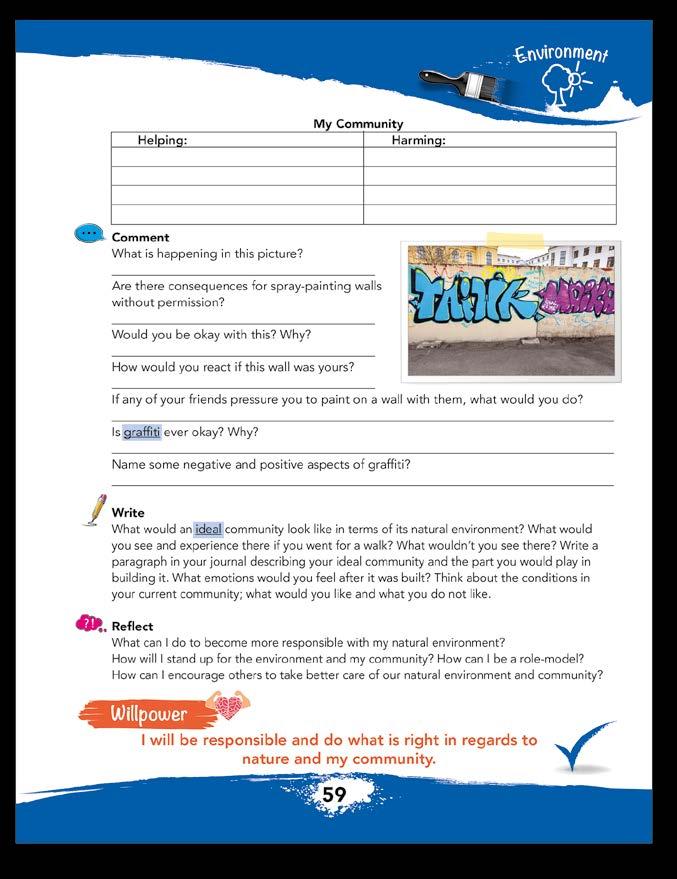
4 minute read
Lesson 4: I Am Special, I Am Unique
Materials
My Best Me textbook, journal, paper, pencil, audiovisual equipment *Book Suggestion: Power Up to Fight Pollution by Lisa Bullard, one of the books from the “Planet Protector” series.
Advertisement
Resources
Student Worksheet: 4yu.info/?i=V598522 Family Engagement: 4yu.info/?i=V598572 Video: Peer pressure - Link: 4yu.info/?i=95211
Glossary
proactive, relax, assume, littered, graffiti, ideal
Motivation
Peer pressure can present itself in many different ways. Many children feel the need to follow the behaviors of a group of peers rather than trust their own instincts and do what they know is right. This lesson addresses how to handle peer pressure both assertively and respectfully, especially when standing up for the natural environment. As humans, we tend to see the errors of others easily, while ignoring our own flaws. Children are no different. In this lesson, it is important for students to become aware of their own “blind spots” regarding their community and environment, so as not to merely point out the flaws of others. While your students might not throw trash on the ground, other behaviors might exhibit their unwise or irresponsible management of natural resources (Do they leave the lights on, let the water run in the shower, throw away otherwise edible food?). As they work through the lesson, emphasize the fact that change starts with each individual’s contribution, as we become more responsible and better stewards of the environment we share. As a result, each student can be a catalyst to encourage others—peers and adults alike—to take better care of the community and the environment. Actions speak far louder than words!
Goal
The students will identify ways to advocate for the protection and care of the natural environment in their community. They will discover how to become more responsible.
Pathways
Observe: Students will observe the images and read the speech balloons. They might justify throwing trash on the ground because people are paid to clean it up. In the cartoon, the bystander is presented with a moral dilemma, since he has to make a choice whether to ignore the situation or confront his “litter bug” friend. This is an introduction to the idea that standing up for what is right may be difficult. What are the alternatives? What if the litterer is not confronted and walks on, leaving the trash on the ground? Should the person addressing him pick up the trash or should it just be left

for the city cleaners? Have students draw/write their own images presenting a parallel situation of their own choosing. Encourage them to include speech balloons if they choose to depict a bystander confronting the offender. Invite the students to write a brief conclusion about how the situation ends. Comment: Students will respond to the images presented in the workbook, discussing and analyzing their own feelings about standing up for the environment and living out their personal convictions. Talk about other common situations where they may be able to use their influence to address irresponsible actions on the part of others when they notice them. Take time to talk about areas in which they themselves need to improve, yet are critical of others. Allow students to elaborate a skit, poem, or story creating a scenario where peer pressure induces action related to the natural environment in their community. Understand: Read and discuss with the students what it means to influence others to become aware of the effects of their behavior on the things around them and act responsibly toward them. You could refer to the title of this lesson and use it to generate a start up question: “Where do our responsibilities begin and end?” Emphasize the strong positive influence each person exerts when acting as an example. Act: Students can work in groups. They will consider their own communities and how well they are being maintained. Ideas to consider are the cleanliness of parks, the availability of recycling bins and trash cans in public spaces, the accessibility of public transportation (to reduce pollution), bike lanes and trails, treatment of animals and their habitats, preservation of land, etc. Comment: Students will observe a photo of graffiti art on a wall, which often is done under peer pressure and not as an approved project, and therefore unlikely to be helpful to the community or to the natural environment. The students will respond to the photo considering their personal feelings about graffiti as well as about being pressured into doing something they do not want to do. Write: Students write or type a paragraph about what their ideal community would look like. Inspire them to take into consideration how complex an ideal community is and the effort it would require to keep it in top condition. The purpose of this is to motivate students to take action in their own communities, protecting and making changes towards a cleaner, healthier environment. Reflect: How can students take a stand for the natural environment?
Willpower
An important part of being a responsible citizen is advocating for the wellbeing of all that is around them; natural resources, and people, including themselves.





